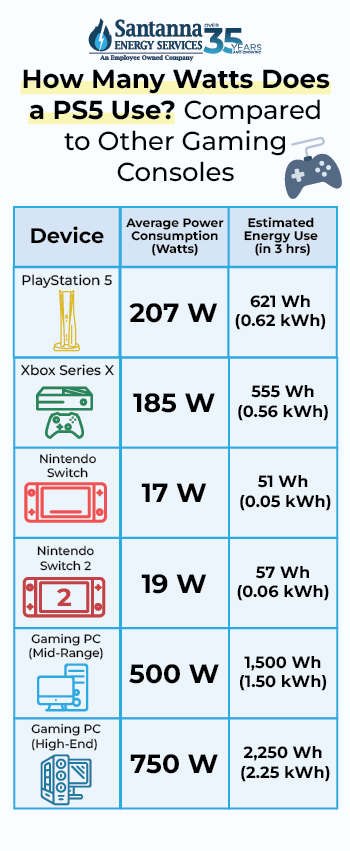How Many Watts Does a PS5 Use? Gaming Energy Explained
by Jenna Mendez
22.2 min read

Are you a longtime gamer wondering just how much electricity your gaming system consumes with every power up? From smart TVs and streaming boxes to gaming consoles, today’s tech keeps our homes buzzing with activity. The PlayStation 5 (PS5), for instance, is more than just a gaming system; it’s a powerful entertainment hub that runs games, movies, and apps all in one place. All that power can really add to your electric bill.
But how many watts does a PS5 actually use? In this guide, we’ll break down the PS5’s power use, what affects it, how it compares to other household electronics, and how you can make smarter choices for a more energy-efficient home. Let’s get started!
Key Points of This Article:
- The PlayStation 5 (PS5) averages around 207 watts during active gameplay, about 55 watts while streaming, and as little as 0.3–3.8 watts in Rest Mode.
- Compared to other gaming systems, the PS5 is more energy-efficient than high-end gaming PCs but consumes more power than handheld consoles like the Nintendo Switch.
- Factors such as game intensity, resolution settings, accessories, and ventilation can significantly affect the PS5’s energy consumption.
- Overall, the PS5 is designed with energy efficiency in mind, using 11–17% less energy than the PS4 launch model, while still delivering high-performance gaming.
What Does Amps, Volts, Watts, Running Watts, Rated Watts, and Watt-Hours Mean?
Before we give you the complete break down of how much electricity your PS5 gaming system uses, let's start with the basics of electricity.
While electricity can seem complicated, it really comes down to a few simple units of measurement. These basic terms help you understand how power flows through your home and in the end, helps you understand just how much energy your devices actually use. Here's what each unit measures and how it relates to your gaming system:
- Amps (A): Amps measure the amount of electricity flowing through a wire. Think of it like how much water moves through a hose at one time. The higher the amps, the more electricity is flowing. At its peak power, a PlayStation uses around 1.7 amps.
- Volts (V): Volts measure the pressure that pushes electricity through the wire. Standard outlets supply about 120 volts, which is the right amount of power for everyday devices like lamps, TVs, and gaming consoles.
- Watts (W): A watt represents a small unit of power that shows how much energy a device uses at a given moment. You can easily find the watts of an appliance by multiplying volts by amps of an appliance together.
- Running Watts: This refers to the steady amount of power a device uses while it's operating normally. This is akin to gaming on your PS5 or when your refrigerator runs to keep your food cool. It's important to note that even when devices aren't actively in use, many still draw small amounts of electricity in the background.
- Rated Watts: This number shows the maximum power a device can use when it's working at full capacity, such as during startup or heavy gaming use.
- Watt-Hours (Wh): This Unit of energy measures the total amount of electrical power used or produced over an hour.
Knowing this basic information about electricity helps you understand how your electricity is measured and how it plays a role in gaming with your PS5. Now for the good stuff! Now that you know this information, it's easier to understand how much energy your gaming counsel consumes.
How Many Watts Does a PS5 Use?
A PS5 consumes varying amounts of power depending on how it's being used. We've found that, based on averages across all PS5 models, the console typically draws around 207 watts during active gameplay.
During streaming, this wattage is cut down significantly, drawing around 55 watts, and when you're hanging out just on the home screen of the console, you draw only 45 watts. In Rest Mode (when your PS5 powers off after gameplay is inactive), overall usage drops significantly, averaging between 0.3 and 3.8 watts, depending on your settings.
In simple terms, your PS5 adjusts its power consumption moment by moment. When you're fully immersed in a fast, graphics-intense game, the console's processor, graphics card, and cooling system are all working at peak performance; similar to a car running at high speed on the highway. But when you're watching a movie, scrolling through the dashboard, or letting it rest between sessions, the system scales back automatically to save energy.
This dynamic power management is part of what makes the PS5 surprisingly efficient for such a powerful machine. It only draws the electricity it needs, when it needs it, keeping performance smooth without wasting energy.
Let's take a closer look at how wattage changes across different PS5 models, and how newer versions have improved efficiency while maintaining the same high-end performance.
PS5 Model and Mode Power Usage Comparison Chart
| Model | Active Gaming (W) | Streaming (W) | Home Menu (W) | Rest Mode (W) |
| PS5 Pro (CFI-7021) | 215–216 | 50 | 44–45 | 0.3–3.6 |
| PS5 (CFI-2016) | 216–218 | 56 | 46–47 | 0.3–3.8 |
| PS5 Digital (CFI-2016B) | 214–218 | 56 | 46–47 | 0.3–3.8 |
| PS5 (CFI-1216A) | 209–211 | 56 | 46–47 | 0.4–4.2 |
| PS5 Digital (CFI-1216B) | 200–201 | 55 | 44–45 | 0.3–3.3 |
| PS5 (CFI-1116A) | 199–201 | 54 | 44–45 | 0.4–3.2 |
| PS5 Digital (CFI-1116B) | 208–209 | 56 | 44–47 | 0.4–3.8 |
| PS5 (CFI-1016A) | 197–198 | 56 | 43–44 | 0.3–3.7 |
| PS5 Digital (CFI-1016B) | 198–200 | 55 | 42–43 | 0.3–3.7 |
Each generation of PS5 has become slightly more efficient, using fewer watts while offering equal or better performance.
According to data from PlayStation.com, the newest Pro version of the PlayStation 5 draws about 8% more power than the original PS5 Digital Edition (CFI-1016B) during active gameplay.
Disc Editions usually consume a little more power because of the drive mechanism, while Digital Editions run leaner overall.
The newest PS5 Pro sits at the top in performance and wattage, but it also includes smarter energy management features designed to limit unnecessary draw when idle or in rest mode.
Is the PS5 Energy Efficient?
You might expect that a console with power like the PS5 would really strain your home's wiring, but it's actually designed with energy efficiency in mind.
According to the game counsel makers themselves, Sony estimates the PS5 uses 11–17% less energy overall than the original PS4 launch model from 2013, despite offering much higher performance.
Compared with earlier PlayStation models, the PS5 includes improvements like a more efficient internal power supply, smarter low-power modes, and better chip designs (AMD Zen 2 / RDNA 2) that help reduce waste when full performance isn't needed.
So yes, the PS5 is more energy efficient than you'd think, especially compared to other home appliances you use every day!
What Affects How Many Watts a PS5 Uses?
As you've read, your PS5 doesn't always use the same amount of power. How much energy it consumes depends on what you're doing, how your gaming system is set up, and even the space around it affects how much energy your PS5 uses. Here's what choices makes the biggest difference:
What You're Playing Matters
High-intensity games with fast motion and detailed graphics make your PS5 work harder, which means it uses more power. In active gaming mode, your PS5 can use anywhere from 200-215 watts. This is as many watts is equivalent to running two bright LED light fixtures, a desktop computer and a small space heater on its lowest setting, all at once!
If you use your PS5 occasionally or mainly for streaming instead of playing graphics-heavy games, it will draw less power, meaning you'll use less electricity overall at around 50-55 watts.
So, if you're looking to save energy while you use your PS5, it's important to be conscious of your usage habits and how you use your system.
Your Settings Make a Difference
Running your console in 4K or "performance mode" gives you sharp visuals and smooth gameplay, but it also increases power use. Choosing a lower resolution or balanced settings can ease the demand without taking away from your experience.
How Long You Play Matters, of Course!
If your PS5 is running for hours (or left on overnight), it keeps drawing power the whole time. Shutting it down or using Rest Mode between sessions can help reduce unnecessary use and keep your console in good shape.
What's Plugged in Adds Up
Extra accessories like headsets, external hard drives, VR sets, and charging docks all use around the same small amounts of energy. On their own, it's minor, but together and left plugged in all day, they can quietly add to your total power use of your gaming session.
Where You Place Your Counsel Matters
If your PS5 sits in a tight or enclosed space, it can get warmer than it should. When that happens, the cooling fans have to work harder, which draws more power. Keeping it in a well-ventilated area helps it run cooler and more efficiently.
What's Running in the Background Counts Too
Even when you're not playing, your PS5 might still be busy downloading updates, syncing data, or charging controllers. These small background processes use energy over time, so adjusting your settings to limit automatic downloads can help.
How Much Electricity Does a PS5 Use?
Just like the wattage, your PS5's electricity use changes depending on how you use it. Gaming draws more power than streaming or browsing the home menu, but even at its peak, it's still modest compared to larger home appliances.
To show you our estimate of just how much electricity a PlayStation 5 uses, we've calculated some quick numbers for you. Using the average wattage from active gaming and streaming modes on a PS5, and converting that into kilowatt-hours (the same unit your electric bill uses), here's roughly what three hours of daily use looks like:
How Much Electricity a PS5 Uses Per Day, Week, Month and Year
| Usage Period | Active Gaming (207 W) | Streaming (55 W) |
| Per Day (3 hrs) | 0.62 kWh | 0.17 kWh |
| Per Week (21 hrs) | 4.35 kWh | 1.16 kWh |
| Per Month (90 hrs) | 18.63 kWh | 4.95 kWh |
| Per Year (1,095 hrs) | 226.67 kWh | 60.23 kWh |
From our data, we found that active gaming draws nearly four times more power than streaming, using about 0.62 kWh per day if you play three hours daily!
How the Electricity Use of a PS5 Compares to Other Gaming Consoles Electricity Use During Active Gameplay
Now that you know the whole picture of your PlayStation 5’s electricity use, let’s see how it compares to other similar gaming systems.
It’s no secret that not all gaming systems use the same amount of power. Consoles are designed to balance high performance with efficiency, but their energy snapshot can look a lot differently when compared to other competitors.
Researching and noting some of the most popular gaming consoles, we’ve calculated and pulled together a table that shows the average power draw (in watts) during active gameplay, along with how much electricity each would use over three hours of play.
Here’s how they all compare:
Power Consumption of Popular Gaming Consoles and PCs (Active Gameplay)
| Device | Average Power Consumption (Watts) | Estimated Energy Use (in 3 hrs) |
| PlayStation 5 (PS5) | 207 W | 621 Wh (0.62 kWh) |
| Xbox Series X | 185 W | 555 Wh (0.56 kWh) |
| Nintendo Switch | 17 W | 51 Wh (0.05 kWh) |
| Nintendo Switch 2 | 19 W | 57 Wh (0.06 kWh) |
| Gaming PC (Mid-Range) | 500 W | 1,500 Wh (1.50 kWh) |
| Gaming PC (High-End) | 750 W | 2,250 Wh (2.25 kWh) |
When it comes to gaming performance, the PS5 delivers impressive power without an excessive energy draw. It sits comfortably between energy-efficient systems like the Nintendo Switch and high-performance setups like gaming PCs.
During active gameplay, the PS5 averages around 207 watts, which is close to the Xbox Series X at 185 watts. In contrast, the Nintendo Switch is far more efficient then both the Xbox Series X and the PlayStation 5, drawing only about 17 watts, a fraction of what full-sized consoles use.
On the other end of the scale, even a mid-range gaming PC can consume roughly 500 watts, while high-end PCs with powerful GPUs often exceed 750 watts. That’s almost 260% more watts than a PlayStation 5!
In simple terms, your PS5 uses around 12 times more power than a standard handheld system, but only about one-third as much as a gaming PC that delivers similar visual performance. This balance gives you smooth, cinematic 4K gameplay while keeping electricity use moderate compared to heavy-duty computers.
If you’re deciding between systems, the PS5 hits an ideal balance; powerful enough for immersive gaming, yet designed with smart energy management that keeps it far more efficient than most high-end PCs.

How Different Counsels Affect Your Energy Use
Your energy use while gaming can vary widely depending on your console, settings, and how long you play.
The PS5, for example, automatically adjusts its power draw based on performance needs, using more electricity during demanding 4K games and much less when streaming or idling on the home screen.
PCs, on the other hand, tend to consume far more energy, while handheld systems like the Nintendo Switch use only a fraction of that.
To put this into perspective, playing on your PS5 for three hours uses about 0.62 kilowatt-hours (kWh) of electricity, which costs roughly 11 cents at the U.S. average rate of 17.47¢ per kWh as of August 2025.The Xbox Series X comes in close at 0.56 kWh (about 10 cents), while a high-end gaming PC can draw around 2.25 kWh, costing 39 cents for the same playtime.
Even lighter activities show clear differences. Streaming movies on your PS5 for three hours uses around 0.17 kWh (about 3 cents), while a Nintendo Switch, drawing roughly 17 watts, uses just 0.05 kWh, costing less than one cent.
If you’re looking to minimize energy use, the Nintendo Switch remains the most efficient option overall. But for immersive gaming, the PS5 strikes one of the best balances between power and efficiency, delivering smooth 4K performance while using far less electricity than a high-end gaming PC.
Simple habits like lowering resolution, enabling Rest Mode, or shutting down after long play sessions can make your gaming setup even more energy-smart.
PS5 vs. Other Appliances: Which Uses More Power?
Now let’s examine how a PS5 compares to other appliances in your home.
Your PS5 might feel powerful, but it’s actually a moderate energy user. While it draws more power than a non-gaming laptop or TV during gaming sessions, it’s nowhere near heavy hitters like air conditioners, heaters, or refrigerators. Let’s see how much power it uses compared to other appliances in your home:
PS5 Power Electricity Usage vs. Everyday Home Appliances
| Appliance | Power (Watts) | Usage Time | Watt-Hours (Wh) |
| PlayStation 5 (Gaming) | 207 W | 3 hours | 621 Wh |
| Ceiling Fan | 60 W | 8 hours | 480 Wh |
| Television | 100 W | 6 hours | 600 Wh |
| Microwave Oven | 1,000 W | 0.5 hours | 500 Wh |
| Air Conditioner | 3,000 W | 8 hours | 24,000 Wh |
| Space Heater | 1,500 W | 8 hours | 12,000 Wh |
| Refrigerator | 500 W | 24 hours | 12,000 Wh |
| Hair Dryer | 1,000 W | 0.5 hours | 500 Wh |
| Laptop | 100 W | 10 hours | 1,000 Wh |
| Dishwasher | 1,800 W | 2 hours | 3,600 Wh |
After crunching the numbers, this is how a PlayStation 5 compares to the energy consumption of other appliances in your home. A 3-hour gaming session on the PS5 uses around 621 watt-hours uses:
- About 30% more energy than a ceiling fan running all day (8 hours).
- Is roughly the same as a 100-watt TV running for six hours.
- Uses around 25% more than using your microwave or hair dryer for a few minutes.
- But uses nearly 85% less energy than a dishwasher cycle.
And when compared to the real power hogs in your home, the difference is huge. Your PS5 uses about 95% less energy than a space heater or refrigerator, and over 97% less than a running air conditioner.
In short, your PS5 packs a punch for gaming, but it's barely a blip compared to what your fridge, heater, or AC uses every day.
How Much Does It Cost to Run a PS5 vs. Other Gaming Systems?
We love calculating this next part because we believe it's the most valuable to you! When evaluating your current gaming system or considering a new one, it's pretty valuable to think: how much does your gaming habit actually cost? Every system draws power differently, and over time, those differences can make a noticeable impact on your energy bill.
To give you a real-life example of what your bill might look like, we've tapped into our employee-owner network to share their experience with gaming. When we asked Santanna employee-owners about their daily gaming habits, 56% said they game between 1–3 hours per day. That might not sound like much, but depending on your console, even a couple hours of gaming a day can add up on your electric bill.
These insights come from our weekly internal Energy Experts survey, where employee-owners share how they manage energy use at home.
As an energy supplier serving Midwest households, we regularly track data from the U.S. Energy Information Administration (EIA) to help customers understand what energy use looks like in real dollars. Based on the EIA's July 2025 average residential electricity rate of 17.47¢ per kilowatt-hour, here's what it costs to power popular gaming systems for two hours a day:
Average Cost to Run a PS5 vs. Other Gaming Systems for 2 Hours a Day (Based on 17.47 Cents per Kilowatt-Hour)
| Device | Avg. Power (W) | 2 Hours/Day | 14 Hours/Week | 60 Hours/Month | 730 Hours/Year |
| PlayStation 5 (PS5) | 207 | $0.07/day | $0.51/week | $2.17/month | $26.40/year |
| Xbox Series X | 185 | $0.06/day | $0.45/week | $1.94/month | $23.59/year |
| Nintendo Switch | 16.5 | $0.01/day | $0.04/week | $0.17/month | $2.10/year |
| Nintendo Switch 2 | 19W | $0.01/day | $0.05/week | $0.19/month | $2.42/year |
| Gaming PC (Mid-Range) | 500 | $0.02/day | $1.22/week | $5.24/month | $63.77/year |
| Gaming PC (High-End) | 750 | $0.26/day | $1.83/week | $7.86/month | $95.65/year |
When you break it down, the PS5 and Xbox Series X fall into the mid-range for energy costs, roughly $25 to $26 per year if you play two hours daily. The Nintendo Switch, by contrast, costs less than $3 per year, making it over 90% more energy-efficient than either full-sized console.
If you’re gaming on a high-end PC, though, your setup uses significantly more power, nearly four times as much energy as a PS5! Even a mid-range PC costs about 70% more to run annually than gaming with a PlayStation 5.
So while your console choice might not change your entire electric bill, these small daily differences can add up.
If you’re a full time gamer looking to get some insight into how much your gaming habits will cost you, this one’s for you.
Hardcore gamers know: performance matters. But power consumption? Not so much. If you’re grinding 8 hours a day, your setup isn’t just heating up the leaderboard; it’s quietly adding to your energy bill. Check out how much money each system really costs when you game 8 hours a day:
Average Cost to Run a PS5 vs. Other Gaming Systems for 8 Hours a Day (Based on 17.47 Cents per Kilowatt-Hour)
| Device | Avg. Power (W) | 8 Hours/Day | 56 Hours/Week | 240 Hours/Month | 2,920 Hours/Year |
| PlayStation 5 (PS5) | 207 | $0.29/day | $2.03/week | $8.68/month | $105.60/year |
| Xbox Series X | 185 | $0.26/day | $1.81/week | $7.76/month | $94.37/year |
| Nintendo Switch | 16.5 | $0.02/day | $0.16/week | $0.69/month | $8.42/year |
| Nintendo Switch 2 | 19 W | $0.03/day | $0.18/week | $0.81/month | $9.70/year |
| Gaming PC (Mid-Range) | 500 | $0.70/day | $4.89/week | $20.96/month | $255.06/year |
| Gaming PC (High-End) | 750 | $1.05/day | $7.34/week | $31.45/month | $382.59/year |
Even with 8 hours of daily gameplay, a PS5 costs just under $8.70 per month to run, making it still one of the most efficient high-performance systems available.
The Nintendo Switch barely makes a dent in your bill, while gaming PCs (especially high-end setups) can cost 3-4 times more to operate over a year than playing a PlayStation 5.
For most players, the PS5 offers the best balance of gaming power and energy efficiency, delivering smooth 4K gameplay without the steep energy costs of a high-end PC.
Choosing Your Next Gaming System: Power Use and Price Compared
If you’re thinking about buying a new gaming system, the choice often comes down to performance, cost, and efficiency.
High-end gaming PCs deliver unmatched customization and speed, but they also come with higher price tags and energy use. Consoles like the PS5 and Xbox Series X, on the other hand, offer powerful performance for far less, both upfront and over time.
Here’s how they compare when it comes to power consumption and average price ranges:
Electricity Cost Comparison of Popular Gaming Systems
| Device | Average Power (W) | Estimated Yearly Electricity Cost (8 hrs/day @ 17.47¢/kWh) | Average Retail Price (USD) |
| PlayStation 5 (PS5) | 207 W | $105.60/year | $549.99 – $749 |
| Xbox Series X | 185 W | $94.37/year | $599.99 – $799 |
| Nintendo Switch | 16.5 W | $8.42/year | $229 – $399 |
| Nintendo Switch 2 | 19 W | $9.70/year | $400 – $699 |
| Gaming PC (Mid-Range) | 500 W | $255.06/year | $1,000 – $1,500 |
| Gaming PC (High-End) | 750 W | $382.59/year | $2,000 – $6,000 |
How Your PlayStation 5’s Energy Use Impacts Your Monthly Bill
Your PS5 might not be the biggest energy user in your home, but like any device, the more you use it, the more it contributes to your overall electricity costs. Its impact depends on two main things: how long it’s running and what you’re doing on it. Gaming in 4K or playing high-performance titles uses more power than streaming shows or leaving it idle.
For example, let’s say you play for about three hours a day, that equals roughly 0.62 kilowatt-hours (kWh) of electricity daily, or around 18.6 kWh per month. Using the U.S. average electricity rate of 17.47¢ per kWh, that’s about $3.25 per month to power your PS5.
If you play twice as long (around six hours a day) that number doubles to 37 kWh per month, or roughly $6.50. It’s not a major expense, but it’s a good reminder of how everyday routines can quietly influence your total energy use, especially when combined with other devices like your TV, speakers, and Wi-Fi router running at the same time.
In short, your PS5’s power use is modest, but being aware of how long it’s on (and what it’s doing) can help you manage energy more efficiently, without missing a minute of play.
Game Without Bill Stress with Santanna’s Unlimited Energy Plan
If you like to game or stream, your energy use can vary a lot from one month to the next. Between marathon game nights, console updates, and hours of streaming, your electricity bill can be unpredictable. That’s where Santanna’s Unlimited Energy plan can make a real difference.
With Unlimited Energy, you pay one flat supply charge each month, no matter how much electricity you use.* That means you can play, stream, or power up your entire entertainment setup without worrying about surprises in the supply charge of your bill.
Whether you’re a weekend gamer or someone who logs in every night, this plan gives you the freedom to enjoy your favorite games with total peace of mind. It’s perfect for:
- Gamers and streamers who fluctuate hours online.
- Households with multiple consoles or gaming PCs.
- Anyone who wants predictability in their monthly energy bill.
How to Reduce Your PS5’s Power Consumption
Reducing your PS5’s power use isn’t just about lowering costs, it’s about helping your console run cooler, last longer, and stay more reliable over time. Here are a few simple ways to make your PS5 more energy efficient:
- Use Rest Mode Smartly: Rest Mode is handy for updates and charging, but it still uses some energy. Turn off features you don’t need, like automatic downloads or staying connected to the internet while in Rest Mode.
- Power Your System Down Completely: If you’re done playing, shut down your PS5 instead of leaving it on. This saves energy and helps prevent unnecessary wear on the system.
- Adjust Your Game Settings: You don’t always need 4K or high-performance mode. Lowering your resolution or brightness can still give you great visuals while using less power.
- Unplug Accessories When Not in Use: Chargers, headsets, and external drives keep drawing small amounts of power even when you’re not using them. Unplug or disconnect them to save energy.
- Keep Your PS5Cool: Good airflow helps your console stay efficient. Avoid closed cabinets or tight spaces so the fans don’t have to work as hard.
- Set Automatic Rest or Power-Off Timers: If you often forget to turn off your PS5, set a timer so it automatically goes into Rest Mode or powers off after being idle.
FAQs
How many watts does an Xbox one use?
An Xbox One typically uses between 119 watts during gameplay, depending on the model and game intensity.
How much electricity does an Xbox use?
On average, an Xbox Series X used for about 3 hours per day consumes around 185 watts per hour, which totals roughly 16.7 kilowatt-hours (kWh) per month.
How many watts is Nintendo switch charger?
A standard Nintendo Switch charger provides 39 watts (15 volts at 2.6 amps). The console itself usually draws less than that during normal use or charging.
Can you use a portable power station to run a PS5?
Yes, as long as the power station provides at least 200–250 watts of continuous output and supports a standard AC outlet.
Is a 600-watt UPS enough for PS5?
Yes, a 600W uninterruptible power supply (UPS) is sufficient for short-term use. The PS5 draws around 200–220 watts while gaming, leaving enough room for your TV or monitor during brief outages.
Can I use a battery backup or generator for PS5 during power outages?
Yes. A battery backup or generator can safely run a PS5 if it provides pure sine wave output and enough wattage (above 250W). Always check that the voltage is stable to avoid damaging the console.
Is it better to turn off your PS5 or put it in rest mode?
Both are safe options. Rest Mode uses very little power and allows background updates and controller charging, while turning off completely saves the most energy. If you’re done for the day, turning it off is best.
What happens if you leave your PS5 on all night?
Leaving your PS5 on all night might not seem like a big deal, but it can do more harm than good over time. When the console runs for hours without a break, it keeps drawing power, generating heat, and putting extra strain on internal parts like the fan and processor.
While one night won’t damage your system, doing it often can shorten your console’s lifespan or lead to slower performance over time. It also keeps using electricity for no real reason—especially if the game is paused or the screen is idle.
Your PS5 is a powerful console, but its energy use is surprisingly modest compared to other household appliances. Like any device, how much electricity it uses depends on your habits, how long you play, what settings you use, and whether it’s running or resting.
The good news is that gaming doesn’t have to mean unpredictable supply charges. With Santanna’s Unlimited Energy plan, you can enjoy your PS5 (and everything else you power at home) without worrying about surprise additions to your supply charges.
Whether you’re streaming, gaming, or pulling an all-nighter with friends, you’ll have the freedom to play as much as you want with one predictable supply charge no matter how much energy you use.*
* Restrictions apply. Enrollment based upon program eligibility. Customers using more than 125% of normal monthly usage as determined by Santanna may be required to switch plans.
Jenna Mendez is a Midwest native with lifelong roots in Illinois and time spent in Ohio during college, giving her a deep understanding of the Midwest region’s people, climate, and energy needs. She brings firsthand experience and local insight to topics that matter to Midwest homeowners, especially energy efficiency, sustainability, and home living. Jenna specializes in writing about eco-friendly living, all things Midwest, renewable energy, and practical ways to reduce energy costs. Jenna brings a trusted, and local hometown voice to every article she writes, helping readers live well, and sustainably, right where they are.







